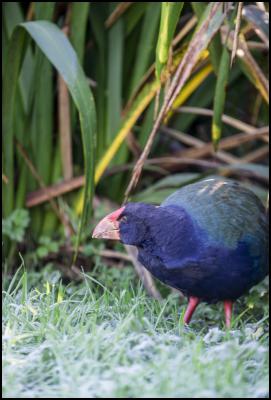Pukaha Mount Bruce saddened by passing of elderly takahē
April 2017
Media
Release
Pukaha Mount Bruce saddened by passing of elderly takahē, Bud.

Bud the Takahe –January 1996- April
2017
A fine trust worthy character who enjoyed the
afternoon sun in his aviary, greeting Pukaha visitors at the
parking lot gate as well as the Pukaha rangers at the
entrance to the Takahe enclosure. (they usually had
food!)
Pukaha Mount Bruce staff and volunteers were deeply saddened by the recent passing of Bud a resident takahē.
Bud celebrated his 21st birthday on January the 7th 2017. Over the past few weeks his health had swiftly deteriorated. Due to his advanced age he was being monitored for age related heart deterioration, cataracts and sudden weight loss.
Bud was one of a pair of takahē at Pukaha Mount Bruce. Bud arrived at Pukaha in 2005 after failing to pair and breed on the predator free island Tiritiri Matangi.
As a youngster Bud had been incorrectly sexed as a female and named “Blossom”. When the mistake was realised, he was renamed to the more gender suitable “Bud”.
Bud had delighted both visitors and the Pukaha team over the years with his kind and trusting manner. Bud could often be seen at Pukaha’s daily takahē talk eating out of a ranger’s hand. “It would never get old, having Bud stroll over to you and take food right from your hand. It was always a bit of a “pinch me, I’m dreaming moment” to be hand feeding such a rare and amazing bird” said Ranger Jess Flamy.
One male takahē, Natural remains at Pukaha Mount Bruce. The Pukaha team are working with the Takahē recovery group to ensure that more takahē will be at Pukaha in the near future. The public is welcome to visit Pukaha and pay their respects to Bud at Pukaha’s daily 10:30am takahē talk.
ENDS:
MORE INFORMATION:
The takahē was once thought to be extinct, but in 1948 it hit world headlines when an Invercargill doctor, Geoffrey Orbell, rediscovered the bird high in the tussock grasslands of the remote Murchison Mountains, Fiordland
Takahē are flightless but can in captivity be long–lived birds. At secure sites they can live for about 20 years or more. They can still be found in the wilds of Fiordland where their maximum lifespan is about 15 years. Alpine, the oldest known takahē, passed away at 27 years old.
Today the work of a small dedicated team of Department of Conservation (DOC) takahē rangers is supported and enhanced by Iwi, scientists, volunteers and the public and private organisations that provide homes and care for our breeding takahē and those birds now retired from the breeding programme. The Takahē Recovery Programme involves a network of people throughout New Zealand, working together to ensure the takahē is never again ‘considered extinct’.
The takahē programme is an important part of Pukaha’s history. In 1955, Elwyn Welch set up what was one of the first “captive native bird facilities” on his farm next door to the Mount Bruce Forest Reserve. The takahē was one of the species Elwyn Welch assisted. Some of Elwyn’s pioneering work to save the takahē have fashioned conservation techniques for protected species in New Zealand and in the world. Elwyn’s work with takahē and several other bird species was moved to the Mount Bruce Forest Reserve in 1962.
It is estimated there are only around 300 takahē remaining. Today the takahē remains critically endangered.


 Oratia Books: New Bilingual Picture Book Of Samoan Proverbs In Time For Samoa Language Week 2025
Oratia Books: New Bilingual Picture Book Of Samoan Proverbs In Time For Samoa Language Week 2025 Headway: Run It Straight
Headway: Run It Straight Tararua Mountain Race: Celebrating 30 Years Of Grit, Community And Wild Beauty
Tararua Mountain Race: Celebrating 30 Years Of Grit, Community And Wild Beauty Public Service Commission: Commissioner To Lead Bargaining With Education Sector
Public Service Commission: Commissioner To Lead Bargaining With Education Sector Athletics New Zealand: 6000 Athletes Set To Tackle Iconic Red Stag Rotorua Marathon
Athletics New Zealand: 6000 Athletes Set To Tackle Iconic Red Stag Rotorua Marathon Hāpai te Hauora: Whānau Stop Smoking For World Smokefree May - That’s Us
Hāpai te Hauora: Whānau Stop Smoking For World Smokefree May - That’s Us